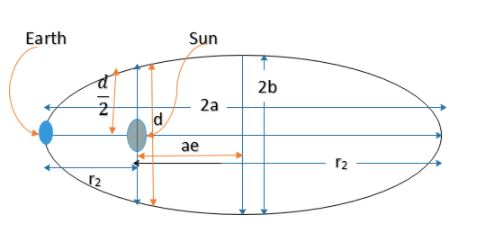
The largest and the shortest distance of the earth from the sun is
Answer
435.2k+ views
1 likes
Hint: The earth rotates around the sun in an elliptical orbit with the sun located at one of its foci. with the largest and the shortest distance of the earth from the sun is
Formula used:
Consider an ellipse having semi major axis length
Eccentricity is given by
The perpendicular distance of directrix from the centre (where the semi major axis and semi minor axis meets) is
We have to calculate half of the directrix. i.e.
Complete step-by-step answer:

According to Kepler’s law of gravitation the earth rotates around the sun in an elliptical orbit with the sun situated in one of the foci of the orbit.
Let the earth rotate around the sun with an elliptical orbit with semi major axis length is
Then the length of the directrix is given by
The distance of Earth from the sun when the earth is at perpendicular to the major axis of the orbit drawn from the sun is
The perpendicular distance of the directrix from the centre (where the semi major axis and semi minor axis meets) is
According to question
So from figure
Now
And ,
But for ellipse the relation between the eccentricity and semi major axis and semi minor axis is
Putting it in above equation we get
Now the directrix is given by
The distance of earth from the sun when the earth is at perpendicular to the major axis of the orbit drawn from the sun is
So the correct option is
So, the correct answer is “Option C”.
Additional Information: Ellipse: It is a curve surrounding two points such that for all points on the curve the sum of the distances to the two fixed points is constant. The two fixed points are called focus of the ellipse.
An ellipse may also be defined in terms of one focus and a line outside of focus and directrix. If the directrix is situated at a distance
Note: The Kepler’s law of planetary motion is valid for every terrestrial object. Newton gave his law of gravitation on the basis of Kepler’s law of planetary motion. Newton gave the following conclusions.
(i)A planet is acted upon by centripetal force directed towards the sun.
(ii)the force acting on the planet is inversely proportional to the square of the distance between the planet and the sun.
(iii)The force acting upon a planet is directly proportional to the product of the masses of the planet and the sun.
Formula used:
Consider an ellipse having semi major axis length
Eccentricity is given by
The perpendicular distance of directrix from the centre (where the semi major axis and semi minor axis meets) is
We have to calculate half of the directrix. i.e.
Complete step-by-step answer:

According to Kepler’s law of gravitation the earth rotates around the sun in an elliptical orbit with the sun situated in one of the foci of the orbit.
Let the earth rotate around the sun with an elliptical orbit with semi major axis length is
Then the length of the directrix is given by
The distance of Earth from the sun when the earth is at perpendicular to the major axis of the orbit drawn from the sun is
The perpendicular distance of the directrix from the centre (where the semi major axis and semi minor axis meets) is
According to question
So from figure
Now
And ,
But for ellipse the relation between the eccentricity and semi major axis and semi minor axis is
Putting it in above equation we get
Now the directrix is given by
The distance of earth from the sun when the earth is at perpendicular to the major axis of the orbit drawn from the sun is
So the correct option is
So, the correct answer is “Option C”.
Additional Information: Ellipse: It is a curve surrounding two points such that for all points on the curve the sum of the distances to the two fixed points is constant. The two fixed points are called focus of the ellipse.
An ellipse may also be defined in terms of one focus and a line outside of focus and directrix. If the directrix is situated at a distance
Note: The Kepler’s law of planetary motion is valid for every terrestrial object. Newton gave his law of gravitation on the basis of Kepler’s law of planetary motion. Newton gave the following conclusions.
(i)A planet is acted upon by centripetal force directed towards the sun.
(ii)the force acting on the planet is inversely proportional to the square of the distance between the planet and the sun.
(iii)The force acting upon a planet is directly proportional to the product of the masses of the planet and the sun.
Latest Vedantu courses for you
Grade 11 Science PCM | CBSE | SCHOOL | English
CBSE (2025-26)
School Full course for CBSE students
₹41,848 per year
Recently Updated Pages
Master Class 9 General Knowledge: Engaging Questions & Answers for Success

Master Class 9 English: Engaging Questions & Answers for Success

Master Class 9 Science: Engaging Questions & Answers for Success

Master Class 9 Social Science: Engaging Questions & Answers for Success

Master Class 9 Maths: Engaging Questions & Answers for Success

Class 9 Question and Answer - Your Ultimate Solutions Guide

Trending doubts
State and prove Bernoullis theorem class 11 physics CBSE

What are Quantum numbers Explain the quantum number class 11 chemistry CBSE

Who built the Grand Trunk Road AChandragupta Maurya class 11 social science CBSE

1 ton equals to A 100 kg B 1000 kg C 10 kg D 10000 class 11 physics CBSE

State the laws of reflection of light

One Metric ton is equal to kg A 10000 B 1000 C 100 class 11 physics CBSE




